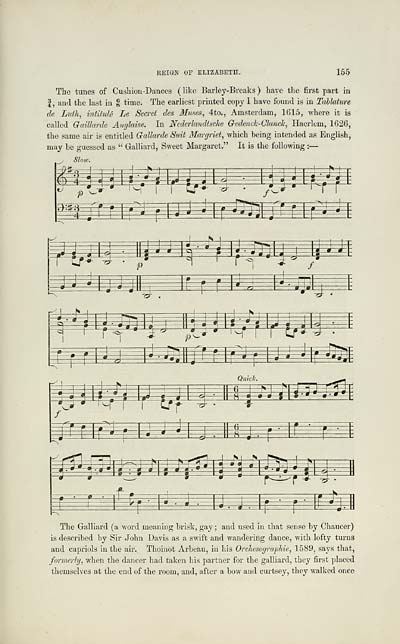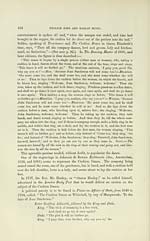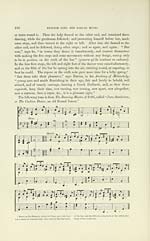Glen Collection of printed music > Printed text > Popular music of the olden time > Volume 1
(189) Page 155
Download files
Complete book:
Individual page:
Thumbnail gallery: Grid view | List view

REIGN OF ELIZABETH.
155
The tunes of Cusliion-Dances ( like Barley-Breaks ) have the first part in
I, and the last in i time. The earliest printed copy I have found is in Tahlature
de Luth, intihiU Le Secret des Muses, 4to., Amsterdam, 1615, where it is
called Gaillarde Anglaise. In Nederlandtsche Q-edenck-Glanck, Haerlem, 1626,
the same air is entitled Grallarde Suit Margriet, -(vhich being intended as English,
may be guessed as " Galliard, Sweet Margaret." It is the following : —
Slo-w.
i
^
a=
FEr^SEE^
k^.
^
=^rf
p
-231-
f
e^£
^ ^^
?E
j =ff ^''T^^=f^^
dS^
fe^
^1
/
i
s
r=&
^
p
m
i=
St
^
^fe^
-I N-
:S^=S=
i
*3t
drV-
^rf=r&
>!■
3e
i^
^^kjj=j.h;=^
aj=y^^=ri
Quick.
zGz
^
Ai 1 _ f —
^ ii a— ■ 8 1 * '
53t±::
^=r-T=&f
/
Bi^^a^^^
S^ESE^
^
:^=e
t
^
E^
1=
^
?^^^^^
The Galliard (a word meaning brisk, gay ; and used in that sense by Chaucer)
is described by Sir John Davis as a swift and wandering dance, with lofty turns
and capriols in the air. Thoinot Arbeau, in his OrchesograpJiie, 1589, says that,
formerly, when the dancer had taken his partner for the galliard, they first placed
themselves at the end of the room, and, after a bow and curtsey, they walked once
155
The tunes of Cusliion-Dances ( like Barley-Breaks ) have the first part in
I, and the last in i time. The earliest printed copy I have found is in Tahlature
de Luth, intihiU Le Secret des Muses, 4to., Amsterdam, 1615, where it is
called Gaillarde Anglaise. In Nederlandtsche Q-edenck-Glanck, Haerlem, 1626,
the same air is entitled Grallarde Suit Margriet, -(vhich being intended as English,
may be guessed as " Galliard, Sweet Margaret." It is the following : —
Slo-w.
i
^
a=
FEr^SEE^
k^.
^
=^rf
p
-231-
f
e^£
^ ^^
?E
j =ff ^''T^^=f^^
dS^
fe^
^1
/
i
s
r=&
^
p
m
i=
St
^
^fe^
-I N-
:S^=S=
i
*3t
drV-
^rf=r&
>!■
3e
i^
^^kjj=j.h;=^
aj=y^^=ri
Quick.
zGz
^
Ai 1 _ f —
^ ii a— ■ 8 1 * '
53t±::
^=r-T=&f
/
Bi^^a^^^
S^ESE^
^
:^=e
t
^
E^
1=
^
?^^^^^
The Galliard (a word meaning brisk, gay ; and used in that sense by Chaucer)
is described by Sir John Davis as a swift and wandering dance, with lofty turns
and capriols in the air. Thoinot Arbeau, in his OrchesograpJiie, 1589, says that,
formerly, when the dancer had taken his partner for the galliard, they first placed
themselves at the end of the room, and, after a bow and curtsey, they walked once
Set display mode to: Large image | Transcription
Images and transcriptions on this page, including medium image downloads, may be used under the Creative Commons Attribution 4.0 International Licence unless otherwise stated. ![]()
| Special collections of printed music > Glen Collection of printed music > Printed text > Popular music of the olden time > Volume 1 > (189) Page 155 |
|---|
| Permanent URL | https://digital.nls.uk/91369715 |
|---|
| Shelfmark | Glen.254 |
|---|---|
| Additional NLS resources: | |
| Attribution and copyright: |
|
| Description | Scottish songs and music of the 18th and early 19th centuries, including music for the Highland bagpipe. These are selected items from the collection of John Glen (1833 to 1904). Also includes a few manuscripts, some treatises, and other books on the subject. |
|---|
| Description | The Glen Collection and the Inglis Collection represent mainly 18th and 19th century Scottish music, including Scottish songs. The collections of Berlioz and Verdi collected by bibliographer Cecil Hopkinson contain contemporary and later editions of the works of the two composers Berlioz and Verdi. |
|---|

